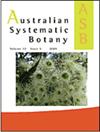干旱的澳大利亚作为植物多样性的来源:苦莲(苋科)的起源和气候演变
IF 1.6
3区 生物学
Q4 EVOLUTIONARY BIOLOGY
引用次数: 1
摘要
在本研究中,我们通过对凤头莲进行近乎全面的采样,重建了一个年代的系统发育,并估计了其祖先的地理范围,从而测试了大部分干旱的澳大利亚凤头莲(苋科)及其近亲(即“aervoids”)的时间和地理起源。我们研究了天莲的气候生态位演变,并通过重建系统发育中气候变量的祖先状态,确定了可能的气候起源和随后的生态位变化,并使用系统生态空间方法对其进行了可视化。利用地理空间分析确定澳大利亚境内可能的多样化热点。我们推测鸟蛋起源于渐新世的非洲-亚洲,而蝶莲花则是在中新世早期扩散到澳大利亚北部的。随后的多角龙的多样化是迅速的,在中新世中期的干旱化时期,产生了西埃及的所有主要分支。气候生态位的变化从干旱的热带地区到季风的北部和温带的南部澳大利亚是明显的多个独立的物种群体。我们的分析支持这样一个假设,即对干旱的预适应和早期到达干旱的澳大利亚是凤头莲成功的必要条件,而且Eremaean已经成为该属生物多样性的来源,并独立辐射到邻近的气候带。本文章由计算机程序翻译,如有差异,请以英文原文为准。
Arid Australia as a source of plant diversity: the origin and climatic evolution of Ptilotus (Amaranthaceae)
In the present study, we tested the chronological and geographic origins of the mostly arid Australian Ptilotus (Amaranthaceae) and its close relatives (i.e. the ‘aervoids’) by reconstructing a dated phylogeny with near-comprehensive sampling for Ptilotus and estimating ancestral geographic ranges. We investigated climatic niche evolution within Ptilotus and identified likely climatic origins and subsequent niche shifts by reconstructing ancestral states of climatic variables on the phylogeny, which was visualised using a phyloecospace approach. Geospatial analyses were employed to identify probable diversification hotspots within Australia. We inferred that the aervoids originated in Oligocene Africa–Asia and that Ptilotus arrived in northern Australia by dispersal in the Early Miocene. Subsequent diversification of Ptilotus was rapid, giving rise to all major clades in the western Eremaean by the time of an aridification pulse in the Middle Miocene. Climatic niche shifts from the arid Eremaean into monsoonal northern and temperate southern Australia are apparent for multiple independent species groups. Our analyses support the hypothesis that a pre-adaptation to aridity and early arrival in an aridifying Australia were integral to the success of Ptilotus, and that the Eremaean has been a source of biodiversity in the genus and for independent radiations into neighbouring climatic zones.
求助全文
通过发布文献求助,成功后即可免费获取论文全文。
去求助
来源期刊

Australian Systematic Botany
生物-进化生物学
CiteScore
3.10
自引率
12.50%
发文量
12
审稿时长
>12 weeks
期刊介绍:
Australian Systematic Botany is an international journal devoted to the systematics, taxonomy, and related aspects of biogeography and evolution of all algae, fungi and plants, including fossils. Descriptive taxonomic papers should normally constitute a comprehensive treatment of a group. Short papers on individual species and nomenclatural papers must contain significant new information of broader interest to be considered. The prestigious L.A.S. Johnson Review Series is published. Other review articles will also be considered. All papers are peer reviewed.
Australian Systematic Botany is published with the endorsement of the Commonwealth Scientific and Industrial Research Organisation (CSIRO) and the Australian Academy of Science.
 求助内容:
求助内容: 应助结果提醒方式:
应助结果提醒方式:


